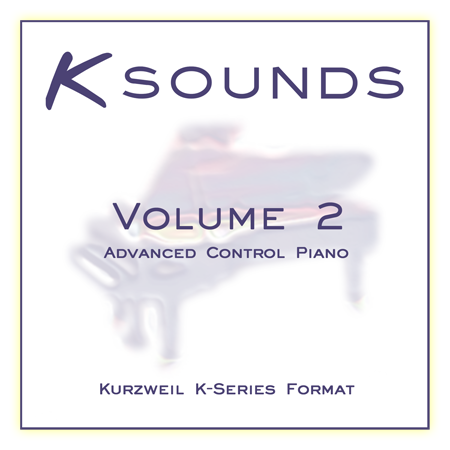
$85.00
Instant Download Specifications- Piano sample library.
- Extra long stereo samples.
- Velocity-switched and single-velocity configurations provided.
- Lush damper resonance effects. (KDFX required.)
- Innovative real-time control options.
Volume 2: Advanced Control Piano is a highly innovative piano sample library for the Kurzweil K2000, K2500, and K2600 that takes user control to a new level. It features a stunning recording of a Kawai EX concert grand piano. With killer sympathetic resonance emulation and sparkling individual samples up to 15 seconds long, no one will know you’re not playing a gigabyte-sized library.
Tone Control
Sophisticated programming gives you real-time control that most piano libraries can only dream about. Using the data slider, you can precisely control the piano’s dynamic response. Want a dark piano? Leave the slider down. Want a greater dynamic range? Push the data slider up. The MIDI specification allows a single program to have 127 incrementally different response curves. Add to that our tonal clarity control, soft pedal control, as well as high and low shelving EQ gain, and the possibilities are truly exciting. Some programs have velocity-controlled high shelving EQ built right into the voicing - no need to waste KDFX power just to have a bright piano. This EQ is also controllable in 127 increments.
Expressive Control
Most piano programs provide the same incremental control over each note’s decay. When the Mod Wheel is down, these pianos sustain beautifully with no compression required. Pushing the Mod Wheel up decreases the sustain, creating a more natural or “live” feel.
Each of the primary piano programs is presented in a second variation with greater velocity control over amplitude. Additional variations include narrower stereo imaging, more prominent sympathetic string resonance, and alternate tuning for layers.
Extensive control over reverb parameters is included as well. By varying level, time, and early-reflection content, users can effortlessly place the piano in a variety of simulated environments using only the front panel sliders.
Polyphony Control
We know you value your Kurzweil’s polyphony. Built into every piano program is a four-zone polyphony prioritization scheme which makes use of Kurzweil’s sophisticated voice allocation. Low notes receive the most priority, followed by the melody range. Less priority is given to the middle high register, and the undampened, highest range of the piano (G6 through C8) receives the least priority. In addition to the four-zone scheme, these programs progressively give notes less priority the longer they are held. (As notes decay, they continually become softer and less noticeable when they are stolen.)
Combined Control
These killer piano programs are conveniently featured in common layered combinations (pads, strings, orchestra, electric pianos, and their variations) – and a few that are uncommon as well. A particular gem is “TIMEstack,” a multi-layer atmospheric combination reminiscent of reality TV. This patch tastefully combines piano with a thick, breathy pad, strings, left hand effects, wind, and percolating synth arpeggios created without using the arpeggiator.
Harnessed Control
With the enormous flexibility of each program, some users may wonder where to start. The answer is found in Setup Mode, where we’ve provided dozens of variations based on the provided programs. Setup Mode allows users to specify starting values for the real-time controllers. By using this feature, users can immediately hear individual piano programs with a variety of musically useful settings. For example, we’ve combined a wide amplitude response, narrow stereo image, rapid note decay, low EQ cut, reverb boost, and early reflection boost to create a convincing recital hall piano. Or to create a “present” piano, we’ve simply set the dynamic response to about 75%, leaving a full sustain and no room simulation. We’ve taken this approach with most of the 71 programs, yielding 160 Setups that cater to an incredibly broad range of musical needs.
Bonus Control
Additional bonus programs are also provided: ROM-based Rhodes with musical velocity crossfading and 8-slider timbre control, warm and breathy pads, wind, and a huge “boom” sound perfect for a musical climax.
RAM Control
This library offers sophisticated control before you even play a note. For optimal RAM management, each sampled note is presented in two different lengths* and three sampling frequencies. Two keymaps are provided as well. All logical combinations are available via Kurzweil’s macro-based automated loading feature, giving users a whopping 21 velocity-switched configurations and 24 single-velocity configurations to choose from.
*Some notes in the highest register come in only one, unlooped length.
Download User Guide K-Sounds Volume 2 - Kurzweil Format User GuideRAM:
- Minimum 16Mb for single velocity banks. Minimum 32Mb for 2-velocity banks.
- 128Mb required for some files.
Operating System:
- K2000: Version 3.87
- K2500: Version 2.88 (units without KDFX) or 5.00 (units with KDFX).
- K2600: Version 3.0
- K2661: Version 1.0 or greater (all versions fully compatible)
Other:
- All models: Contemporary ROM is used for piano-bass split.
- K2000: P-RAM is recommended, but not required.
All demos were created exclusively on a Kurzweil K2500 with KDFX. No additional processing was used. What you hear is Volume 2 only.
Solo Pianos Studio Piano Full Piano Bright Piano Warm Piano Stadium Piano Layered Pianos Piano and FM EP Piano and Tine EP Piano and Pad Piano and Pad Demo 2 Piano and Strings Back to Church (Contemporary ROM Required) TIMEstack Bonus Sounds Tine EP FM-Tine EP Hybrid Breathy Pad Warm Saw Pad Mix Demos Orchestral Mix Light Jazz Mix Rock Mix - Also features KS Rotary. Other instruments provided by Motif ES.